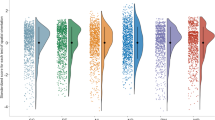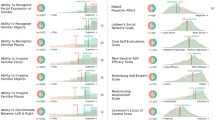Abstract
Members of 192 families in the Tel Aviv area were given a battery of eight cognitive tests focusing on spatial measures but sampling verbal, numerical, and perceptual speed domains as well. The patterns of parent-child and sibling correlations gave very weak evidence, if any, for the operation of the X-linked recessive gene postulated by Stafford and others to affect performance on tasks involving spatial visualization. An analysis of male and female score distributions provided results more favorable to the X-linkage hypothesis, at least for the child generation, although suggesting that X linkage does not explain the whole male-female difference in performance on spatial tasks.
Similar content being viewed by others
References
Bock, R. D., and Kolakowski, D. (1973). Further evidence of sex-linked major-gene influence on human spatial visualizing ability.Am. J. Hum. Genet. 25:1–14.
Bouchard, T. J., and McGee, M. G. (in press). Sex differences in human spatial ability: Not an X-linked recessive gene effect.Soc. Biol.
Chu, P.-F. M. (1977). A Chinese family study of spatial ability. Unpublished M.A. thesis, University of Texas at Austin.
Crow, J. F., and Felsenstein, J. (1968). The effect of assortative mating on the genetic composition of a population.Eugen. Q. 15:85–97.
Day, N. E. (1969). Estimating the components of a mixture of normal distributions.Biometrika 56:463–474.
DeFries, J. C., Ashton, G. C., Johnson, R. C., Kuse, A. R., McClearn, G. E., Mi, M. P., Rashad, M. N., Vandenberg, S. G., and Wilson, J. R. (1976). Parent-offspring resemblance for specific cognitive abilities in two ethnic groups.Nature 261:131–133.
Eaves, L. J. (1973). Assortative mating and intelligence: An analysis of pedigree data.Heredity 30:199–210.
Ekstrom, R. B., French, J. W., and Harman, H. H. (1976).Manual for Kit of Factor-Referenced Cognitive Test 1976. Educational Testing Service, Princeton, N.J.
French, J. W., Ekstrom, R. B., and Price, L. A. (1963).Manual for Kit of Reference Tests for Cognitive Factors, Educational Testing Service, Princeton, N.J.
Guttman, R. (1974). Genetic analysis of analytical spatial ability: Raven's Progressive Matrices.Behav. Genet. 4:273–284.
Hartlage, L. C. (1970). Sex-linked inheritance of spatial ability.Percept. Motor Skills 31:610.
Insel, P. (1971). Family similarities in personality, intelligence and social attitudes. Unpublished doctoral disseration, University of London.
Insel, P. M. (1974). Maternal effects in personality.Behav. Genet. 4:133–143.
Jinks, J. L., and Fulker, D. W. (1970): Comparison of the biometrical genetical, MAVA, and classical approaches to the analysis of human behavior.Psychol. Bull. 73:311–349.
Stafford, R. E. (1961). Sex differences in spatial visualization as evidence on sex-linked inheritance.Percept Motor Skills 13:428.
Stafford, R. E. (1963).An Investigation of Similarities in Parent-Child Test Scores for Evidence of Hereditary Components, Research Bulletin (RB-63-11), Educational Testing Service, Princeton, N.J.
Wilson, J. R., DeFries, J. C., McClearn, G. E., Vandenberg, S. G., Johnson, R. C., and Rashad, M. N. (1975). Cognitive abilities: Use of family data as a control to assess sex and age differences in two ethnic groups.Int. J. Aging Hum. Devel. 6:261–275.
Yen, W. M. (1975). Sex-linked major-gene influences on selected types of spatial performance.Behav. Genet. 5:281–298.
Author information
Authors and Affiliations
Additional information
This research was supported by funds from NSF Grant GU-1598 to the University of Texas.
Rights and permissions
About this article
Cite this article
Loehlin, J.C., Sharan, S. & Jacoby, R. In pursuit of the “spatial gene”: A family study. Behav Genet 8, 27–41 (1978). https://doi.org/10.1007/BF01067702
Received:
Accepted:
Issue Date:
DOI: https://doi.org/10.1007/BF01067702




